Identifying External Strategic Factors
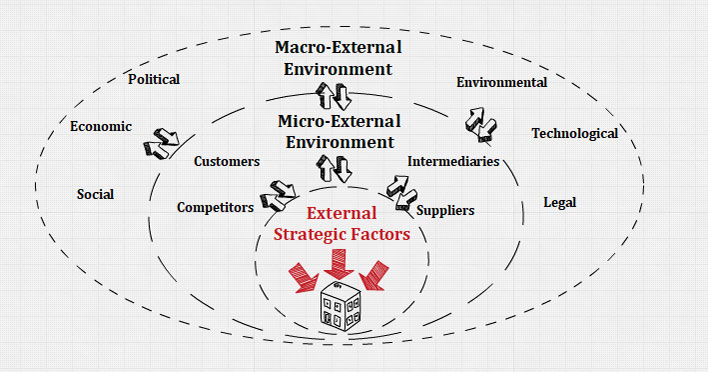
Recognizing and understanding external strategic factors are among the main reasons for the differences in performance between organizations.
External strategic factors affect the types of products developed, the nature of positioning and market segmentation strategies, the type of services offered, and the choice of businesses to acquire or sell. Changes in external strategic factors translate into changes in consumer demand for both industrial and consumer products and services.
External strategic factors directly affect both suppliers and distributors. Identifying and evaluating external opportunities and threats enables organizations to develop a clear mission and to design strategies to achieve the objectives of the organization.
No firm can successfully monitor all external factors. Choices must be made as to whether a particular factor is important. Sometimes crucial new development of the external environment is ignored or missed due to misinterpretation from management. Personal values and experiences of management can explain the bias in both their perception of what is important to monitor and their interpretation of what they perceive. Firms should be able to respond either offensively or defensively to the factors by formulating strategies that take advantage of external opportunities or that minimize the impact of potential threats.
External strategic factors of an organization are then judged as trends that have both a medium to high probability of occurrence and a medium to high probability of impact on the organization. Those trends judged to be strategic factors are then categorized as opportunities and threats and are included in strategic formulation.
External Strategic Factors Analysis Process
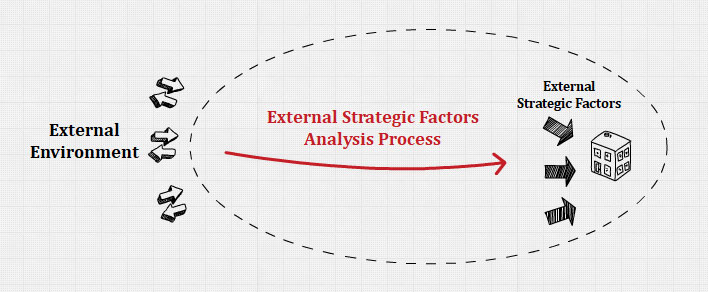
One way to identify and analyze developments in the external environment is to use an issues priority matrix. This practice consists of the following steps:
- Scan trends emerging in natural, societal, and task environments,
- Forecast probability of these trends actually occurring, from low to medium to high, and
- Assess the impact of each trend on the organization, from low to medium to high.
In the next 3 sections, these steps will be examined in detail.
Identifying opportunities and threats is an important objective of studying the external environment. An opportunity is a condition in the external environment that, if exploited effectively, helps a company reach strategic competitiveness. A threat is a condition in the external environment that may hinder a company’s efforts to achieve strategic competitiveness.
Most firms face external environments that are turbulent, complex, and global. These conditions make interpreting those environments more difficult. To cope with often ambiguous and incomplete environmental data and to increase understanding of the external environment, including both macroenvironment and microenvironment, firms initiate an external environmental analysis.
Process Step 1: Scanning
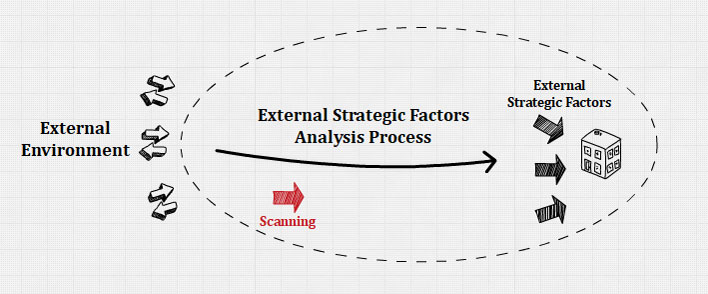
What is Scanning?
Scanning entails the study of all segments in the external environment, including macroenvironment and microenvironment.
Through scanning, firms identify early signals of potential trends in the environment and detect events that are already underway. Executives must observe environmental changes to see if an important trend is emerging from among those spotted through scanning. It is critical to successful scanning that a firm detects true meaning in environmental events and trends.
Although challenging, scanning is critically important to the firms’ efforts to understand trends in these environments and to anticipate their implications. This is particularly the case for companies competing in highly volatile environments.
Scanning activities must be aligned with the organizational context. A scanning system designed for a volatile environment is inappropriate for a firm in a stable environment.
Scanning often reveals ambiguous, incomplete, or unconnected data and information that require careful analysis.
Many firms use special software to help them identify events that are taking place in the environment and that are announced in public sources. News event detection uses information-based systems to categorize text and reduce the trade-off between an important missed event and false alarm rates. Increasingly, these systems are used to study social media outlets as sources of information.
How Company Implements Scanning
There are 4 steps that a company may go through during the implementation of strategic factors scanning.
An external strategic factors analysis process focuses on identifying trends and events beyond the control of a single firm, such as increased foreign competition, an aging society, consumer fear of traveling, and stock market volatility. It reveals key opportunities and threats confronting an organization so that managers can formulate strategies to take advantage of the opportunities and avoid or reduce the impact of threats.
The process of performing an external environment scanning must involve as many managers and employees as possible. Individuals appreciate having the opportunity to contribute ideas and to gain a better understanding of their firms’ industry, competitors, and markets.
Step 1: To perform an external environment scanning, a company first must gather competitive intelligence and information about natural, societal, and task environments.
Step 2: Individuals can be asked to monitor various sources of information, such as key magazines, trade journals, and newspapers. These persons can submit periodic scanning reports to a committee of managers charged with performing the external environment scanning. This approach provides a continuous stream of timely strategic information and involves many individuals in the external environment scanning process.
Step 3: Once information is gathered, it should be assimilated and evaluated. A meeting or series of meetings of managers is needed to collectively identify the most important opportunities and threats facing the firm. A prioritized list of these factors could be obtained by requesting that all managers rank the factors identified. These key external factors can vary over time and by industry.
Relationships with suppliers or distributors are often a critical success factor. Other variables commonly used include market share, breadth of competing products, world economies, foreign affiliates, proprietary, and key account advantages, price competitiveness, technological advancements, population shifts, interest rates, and pollution abatement.
In general, key external factors should be (1) important to achieving long-term and annual objectives, (2) measurable, (3) applicable to all competing firms, and (4) hierarchical in the sense that some will pertain to the overall company and others will be more narrowly focused on functional or divisional areas.
Step 4: A final list of the most important key external factors should be communicated and distributed widely in the organization. Both opportunities and threats can be key external factors.
Process Step 2: Forecasting
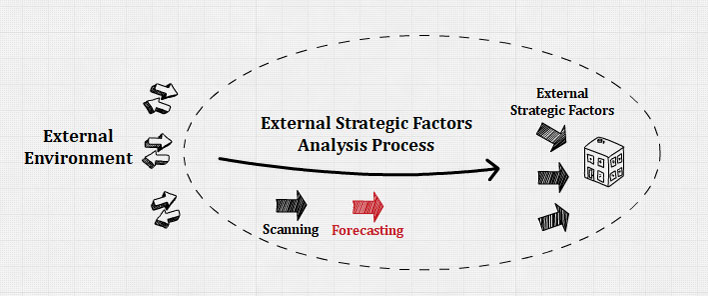
What is Forecasting?
Forecasting generates forecasts that are educated assumptions about future trends and events emerging from the scanning process.
In forecasting, executives look at the events and trends presented in the scanning step and develop feasible projections of which trends and events might happen.
Forecasting is a complex activity because of factors such as technological innovation, cultural changes, new products, improved services, stronger competitors, shifts in government priorities, changing social values, unstable economic conditions, and unforeseen events. Management often must rely on published forecasts to effectively identify key external opportunities and threats.
A sense of the future permeates all action and underlies every decision a person makes. People eat expecting to be satisfied and nourished in the future. People sleep if in the future they will feel rested. They invest energy, money, and time because they believe their efforts will be rewarded in the future. They build highways if automobiles and trucks will need them in the future. Parents educate children based on forecasts that they will need certain skills, attitudes, and knowledge when they grow up.
The truth is we all make implicit forecasts throughout our daily lives. The question, therefore, is not whether we should forecast but rather how we can best forecast to enable us to move beyond our ordinarily unarticulated assumptions about the future. Forecasting events and outcomes accurately are challenging. Can we obtain information and then make educated assumptions (forecasts) to better guide our current decisions to achieve a more desirable future situation?
Sometimes organizations must develop their own projections. Most organizations forecast (project) their own revenues and profits annually. It is also critical that organizations can forecast the time that will be required for a trend to take place, the length of time before different corporate training procedures are required to deal with anticipated changes, or how much time will elapse before one change affects others.
Key external opportunities and threats can be effectively identified only through good forecasts. Accurate forecasts can provide major competitive advantages for organizations. Forecasts are vital to the strategic management process and to the success of organizations.
Environment scanning provides hard data on current situations and trends, but intuition will play a part in anticipating whether these trends will continue in the future. Resulting forecasts are, to a certain extent, based on a set of assumptions that may or may not actually be valid.
Planning would be impossible without assumptions. Strategists are faced with countless variables and imponderables that can be neither controlled nor predicted with 100 percent accuracy. Wild guesses should never be made in formulating strategies, but reasonable assumptions based on available information must always be made.
By identifying future occurrences that could have a major effect on the firm and by making reasonable assumptions about those factors, strategists can carry the strategic management process forward. Assumptions are needed only for future trends and events that are most likely to have a significant effect on the company’s business.
Faulty underlying assumptions are the most frequent cause of forecasting errors. Nevertheless, many managers who formulate and implement strategic plans rarely consider that their success is based on a series of basic assumptions.
Based on the best information at the time, assumptions serve as checkpoints on the validity of strategies. If future occurrences deviate significantly from assumptions, strategists know that corrective actions may be needed. Without reasonable assumptions, the strategy formulation process could not proceed effectively. Firms that have the best information generally make the most accurate assumptions, which can lead to major competitive advantages.
Forecast Techniques Company Can Utilize
These 7 techniques are among the most frequently used techniques that can be applied to forecast future situations.
The first technique is extrapolation, which is the extent of present trends into the future. It is based on an assumption that the world will be reasonably consistent in the short run. Past events are generally carried forward into the future.
The basic problem with this approach is that historical trend is based on a series of patterns or relationships among so many different variables that a change in any of them can drastically change the future direction of the trend.
Usually, the further back into the past you can find relevant data supporting the trend, the more confidence you can have in the anticipation of the future.
The second technique is brainstorming, which is a non-quantitative approach that would require a group of people with knowledge and expertise of the situation. The basic ground is to propose ideas without first screening them. All ideas are encouraged and acknowledged.
The third technique is expert opinion, which is also a non-quantitative approach in which experts in a particular attempt to forecast the likely development of trends. This forecast type is based on the ability of a knowledgeable person to construct reliable future developments.
The fourth technique is Delphi technique, which is an approach that separated experts independently assess the likelihood of specific events. These assessments are combined and delivered back to each expert for revision until mutual consensus is reached.
The fifth technique is statistical modeling, which is a quantitative approach that attempts to discover causation factors that link two or more time-series together. Examples of this technique include regression analysis or econometric methods.
The sixth technique is prediction markets, which is an approach that is enabled because of easy access to the Internet. The basic ground for this technique to work is the conclusions of large groups can often be better than those experts since they can aggregate a larger amount of wisdom.
Prediction markets have not been documented for long-term forecasting, so its value in strategic planning has not yet been well established.
The seventh technique is scenario writing, which is one of the most widely used forecasting techniques, after trend extrapolation. Scenarios are descriptions of different likely future outcomes. Thus, a scenario may be a simple written description or may be generated in combination with other forecasting techniques.
Process Step 3: Assessing
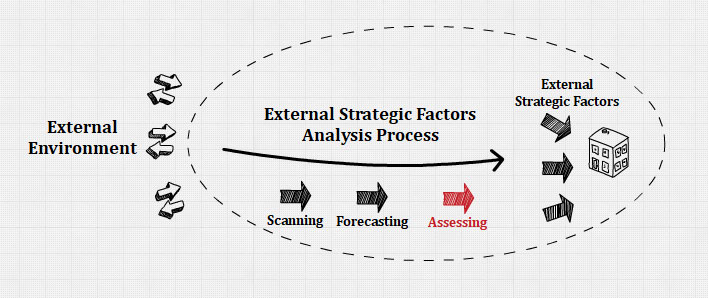
The assessing step is to determine the timing, significance, and impact of the effects of environmental changes and trends that have been identified.
Through scanning and forecasting, organizations are able to understand the environment. In this step of the process, the main intention is to specify the implications of that understanding. Without assessment, the firm has data that may be interesting but of unknown competitive relevance.
Accurately assessing the trends and events expected to take place in the segments of a firm’s environment is important. However, accurately interpreting the meaning of those trends and events is even more important. Organizations are required to classify these trends and events in the environment as opportunities or threats. Even in certain cases where formal assessment is inadequate, the appropriate interpretation of that information is very important.
These opportunities and threats are used as part of an analysis to identify and select feasible strategies that will enable the company to outperform its rivals in the market. Opportunities arise when a company can take advantage of conditions in its environment to formulate and implement strategies that enable it to become more profitable. Threats arise when conditions in the external environment endanger the integrity and profitability of the company’s business.
Resources
Further Reading
- How To Identify External Factors That May Affect Your Strategic Plan (clearpointstrategy.com)
- External Factors (futurelearn.com)
- Environmental Factors in Strategic Planning (leoisaac.com)
- What Are Internal & External Environmental Factors That Affect Business (mageplaza.com)
- External Factor Evaluation (EFE) for competitive analysis (thinkinsights.net)
- External Factors that Affect a Business (pestleanalysis.com)
- Assessing Your External Environment (literacybasics.ca)
- Environmental Scanning – Internal & External Analysis of Environment (managementstudyguide.com)
Related Concepts
- Business External Environment Components
- Macro Environment Forces (Fully Explained)
- Industry Environment Analysis
References
- Hitt, M. A., Ireland, D. R., & Hoskisson, R. E. (2019). Strategic Management: Concepts and Cases: Competitiveness and Globalization (MindTap Course List) (13th ed.). Cengage Learning.
- Mastering Strategic Management. (2016, January 18). Open Textbooks for Hong Kong.
- Wheelen, T. L. (2021). Strategic Management and Business Policy: Toward Global Sustainability 13th (thirteenth) edition Text Only. Prentice Hall.